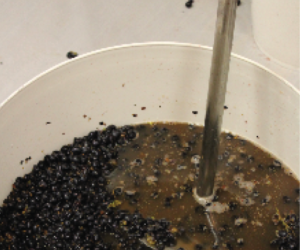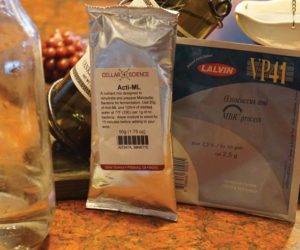
Q
After I stabilized my wine, I added French medium toast oak beans to the Chardonnay 3/4 cup (new beans), Sauvignon Blanc 1/3 cup (new beans), Ruisseau Blanc 3/4 cup (used beans), and French Colombard 3/4 cup (used beans). All the wines are 19 L. Only the Chardonnay turned milky, cloudy and hazy. I used Claro K.C. a fining mixture made up of kieselsol and gelatin. I mixed in the kieselsol and in 12 hours there was 1/2 inch of sediment that had collected on the bottom. I racked the wine before adding the clarifier or gelatin. After three days there was another 1/2 inch of white sediment. The wine is becoming very clear with that delicate straw color. Why did only the Chardonnay react while the others remained crystal clear?
Robert A. Klaus
Houston, Texas
A
You present an interesting situation, one that is common to all winemakers: Why does one batch do something screwy when other batches, treated the same way, do not? The answer is that all wines are different and will react accordingly – or not. Wine will be wine and sometimes no matter how hard we try to figure out its whims and whiles, all we can do is sit back, watch, wait and wonder.
Your situation is not hopeless, though the lesson still applies. My experience leads me to think that you’ve experienced a peptide-tannin haze. Adding oak beans (bean size chips), chips, sticks or powder to wine imparts oak tannins. Tannins will bind to the proteins naturally present in wine and may cause them to fall out of solution as the tannin-protein complexes become too large to remain soluble. This results in visible (though still tiny) particles floating in your wine. With time, these might eventually settle out, but using Kieselsol was the right thing to do.
Kieselsol (also known as silica sol) is a silica suspension used for settling or clarification applications. Used in conjunction with gelatin, it is particularly good at settling out protein-tannin complexes that have formed a haze in the wine. The mechanism of settling is not 100% understood but it seems that the added gelatin precipitates out the tannin while the silica prevents an excess of gelatin from remaining in the wine. What results is a layer of sediment on the bottom of ones carboy, keg or, if the tannin is added too close to bottling time, in the bottle. The good news is that this sediment is expected, natural and easy to rack off.
Back to the issue as to why only the Chardonnay went hazy: Each grape and wine will have its own unique level of protein and tannin present to make these unsightly hazes and it’s hard to predict how different wines will react to the same treatment. There are many tannins naturally present in grapes and, as a result, in finished wines. In seeded fresh wine grapes, tannins are present in amounts upwards of 1000 mg/Kg fresh weight. Red grapes and white grapes have them as do all finished wines. White has considerably less tannins then red. Because of their high concentration and the multifaceted diversity in the make-up of grapes, juices and wines, the tannin profile is one of the main characteristics that is used to differentiate between grape varietals. In other words, the wines you’ve got all will have different kinds and levels of tannins in them as they’re all different varieties.
Each wine will have its unique protein signature as well, especially if the wines were fermented with different yeasts, underwent malolactic fermentation, had a high microbial load at some point in their lives or didn’t have any fining agent that would affect the protein situation (like bentonite) added to them. It’s possible that the Chardonnay and its resident proteins were chemically “ready” to bind with any tannins that happened to come their way and the cup of new oak chips you added pushed that equilibrium over the edge. New oak chips will have, by definition, more available tannin for peptide-tannin bonding, giving another possible reason why your other batches didn’t form hazes.
Predicting when tannin-peptide hazes will and will not occur is difficult, but it seems like you’ve found a way to deal with it when it does. I don’t suggest not using oak in wine in order to avoid hazes – we would be throwing centuries of vinification history out the window if we stopped using barrels and other oak products. All we can do is evaluate each situation as it comes along.
Q
I’m new to wine making but I have made beer and mead for three years. What types of grapes and yeast are used to make lambrusco wine? Also the variety of grapes that I’m growing are lambrusca riparia. Does this have any connection to the lambrusco wine style? I have some grape vines that I planted two years ago that are doing well and hope that next season I’ll have enough grapes to make a little wine from them. I am thirsty for more information!
Dean Bialozynski
Pulaski, Wisconsin
A
This is a good group of questions! The wine world has lots of similar-sounding names for things that understandably confuse many.
Lambrusco is a grape varietal of the vitis vinifera species. It is of Italian origin and is primarily grown in the three central provinces of Emilia: Reggio nell’Emilia, Parma and Modena. There are at least 60 known sub-varieties of this grape, so the styles vary widely. It has been known to find its way into red, rosé, still, sparkling and sweet wines as well as your ordinary dry table fare! It became quite the hit in the U.S. in the 1970s and early 1980s when a bunch of Italian wineries got together and decided to export about 3 million cases of a slightly sweet, red version to North America.
The variety is actually called labrusca-riparia. This grape variety is an American hybrid, a cross between the American natives vitis labrusca and vitis riparia. The labrusca varieties are those of Welch’s Grape Juice fame and often are characterized by what is called a “foxy” aroma, described as somewhat musky or putrid according to some. Vitis riparia is a different grape whose latin name means “river bank” and can often be found living along waterways, especially in the east and southeast of North America.
These two grapes, lambrusco and vitis labrusca-riparia, are in the same genus, vitis, but beyond that are completely different species of plants. The styles of wine they’ll make are completely different as well, the salient characteristic being the lambrusco’s lack of the American “Concord” or “foxy” aroma.
For more of the Wine Wizard’s wisdom, pick up the latest issue of WineMaker, available at better winemaking supply shops and newsstand locations.






